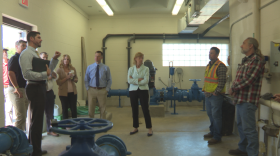The City of Rhinelander is happy to see some progress made on setting PFAS standards.
Last month, the Natural Resources Board approved setting a DNR drinking water standard of 70 parts per trillion (PPT) for two of the more widely studied PFAS chemicals: PFOA and PFOS.
The standard still needs legislature approval.
It’s been more than two and a half years since Rhinelander shut down two of its wells over PFAS concerns.
The city continues to operate with just three other active wells.
Well 7 was shut down over high levels of PFOA and PFOS. Those are in the PFAS family of manmade chemical linked to health risks.
The combined level of PFOA and PFOS peaked at 104.8 PPT. That’s nearly 35 PPT more than the standard recently set by the Wisconsin DNR’s policy board.
While the DNR had recommended a level of just 20 PPT, in line with the Department of Health Services recommended PFAS level, Rhinelander City Administrator Zach Vruwink said the city is hopeful about the progress being made in setting any standards.
“It’s really important for us operationally as we try to pursue various treatment options, or in the case of adding a new well, we need to know what the safe standard is to be able to provide those utilities to the public. Without having a standard we’re really left in a limbo state, something we’ve been operating with for some time now,” said Vruwink.
Vruwink understands that any-level of the chemicals may make people uneasy but says having some standard is better than nothing.
“As the city of Rhinelander considers its operational needs as well as restoring the two wells that are currently suspended into service, having those standards gives us somewhat of a playbook to work toward,” he said.
Well 8 is the other Rhinelander well that’s shutdown.
It had PFHxS levels peaking at 95.7 parts per trillion when it was shutdown. Those PFAS chemicals were not included in the NRB’s standard.
Update on Rhinelander's PFAS situation
Vruwink said the city is still testing for PFAS in its operational wells quarterly.
It also has a small role in testing private wells around the Rhinelander-Oneida County Airport.
That’s a recent initiative by the county and airport that is just getting started.

The city’s response has also included UW-Madison researchers trying to map out the extent of the PFAS problem in the area, studies to figure out the sources of the contamination, and an effort to build a new well.
Vruwink says the latter, as well treatment options, are currently dependent on state and federal funding, including provisions in a long-term spending bill that has yet to be picked up by federal lawmakers.
“Within that long-term government funding bill is the inclusion of an earmark. Sen. Baldwin had included a recommendation for consideration for treatment here at the two wells. We’re optimistic that Congress will come together to debate and hopefully approve a longer-term spending bill versus these short-term, month by month, or few month extensions,” said Vruwink.
It’s still all voluntary as there are no state or federal requirements to do so.










